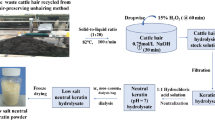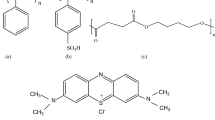Abstract
Due to the high toxicity of effluents radiating from tannery industries, there is a need for effluent treatment so as to limit its dangerous impacts on the environment. Fabricating responsive membranes is gaining significant interest in wastewater treatment applications. This study investigates the preparation, characterization, permeation, and antifouling properties of the keratin-polysulfone blend membranes. Keratin, a bioinspired material, is used as the responsive element along with the polysulfone matrix, which together acts as the responsive membranes for efficient filtration. Keratin was extracted from the goat hair, a tannery waste, through ball milling—an ecological, cost-effective, and time-consuming method. Keratin-polysulfone was blended in the ratio 95:5 (v/v) in their respective solvents to prepare nanofiltration membranes. The morphology of the membranes shows the random arrangement of fibers with the interstitial spaces. Contact angle measurements reveal that the keratin-polysulfone blend membranes are partially hydrophilic, which in turn resulted in good antifouling properties. Improved porosity of the fabricated membranes enabled good absorption capacity, and enhanced mechanical properties are an added advantage for the fabricated membranes. Since the membrane showed enhanced filtration property, the post-tanning effluents from the leather industry have been treated by the keratin-polysulfone fabricated membranes. The treated effluent showed a maximum percentage reduction in chemical oxygen demand (COD) and biological oxygen demand (BOD) concentrations of about 53% and 66%, respectively. The dye removal efficiency of the fabricated membrane is reported to be 76%. Thus, filtration efficiency has been established paving a way for treating effluents in an efficient way.







Similar content being viewed by others
References
Baker, R. W. (2004). Membrane technology and applications. Wiley https://books.google.co.in/books?id=8yAKX0NluFEC.
Basile, A., Cassano, A., & Rastogi, N. K. (2015). Advances in membrane technologies for water treatment: materials, processes and applications. Elsevier Science https://books.google.co.in/books?id=5UOdBAAAQBAJ.
Bhardwaj, N., & Kundu, S. (2010). Electrospinning: a fascinating fiber fabrication technique. Biotechnology Advances, 28, 325–347. https://doi.org/10.1016/j.biotechadv.2010.01.004.
Caetano, A., de Pinho, M. N., Drioli, E., & Muntau, H. (2012). Membrane technology: applications to industrial wastewater treatment. Springer Netherlands https://books.google.co.in/books?id=_35yBgAAQBAJ.
Chen, X., Wu, S., Yi, M., Ge, J., Yin, G., & Xinming, L. (2018). Preparation and physicochemical properties of blend films of feather keratin and poly(vinyl alcohol) compatibilized by tris(hydroxymethyl)aminomethane. Polymers, 10, 1054. https://doi.org/10.3390/polym10101054.
Chowdhury, M., Mostafa, M. G., Biswas, T. K., Mandal, A., & Saha, A. K. (2015). Characterization of the effluents from leather processing industries. Environmental Processes, 2(1), 173–187. https://doi.org/10.1007/s40710-015-0065-7.
Chowdhury, M. R., Huang, L., & McCutcheon, J. R. (2017). Thin film composite membranes for forward osmosis supported by commercial nanofiber nonwovens. Industrial & Engineering Chemistry Research, 56(4), 1057–1063. https://doi.org/10.1021/acs.iecr.6b04256.
Cooman, K., Gajardo, M., Nieto, J., Bornhardt, C., & Vidal, G. (2003). Tannery wastewater characterization and toxicity effects on Daphnia spp. Environmental Toxicology, 18(1), 45–51. https://doi.org/10.1002/tox.10094.
Dobosz, K. M., Kuo-Leblanc, C. A., Martin, T. J., & Schiffman, J. D. (2017). Ultrafiltration membranes enhanced with electrospun nanofibers exhibit improved flux and fouling resistance. Industrial & Engineering Chemistry Research, 56(19), 5724–5733. https://doi.org/10.1021/acs.iecr.7b00631.
Ghosh, A., & Collie, S. (2014). Keratinous materials as novel absorbent systems for toxic pollutants. Defence Science Journal, 64(3), 209–221. https://doi.org/10.14429/dsj.64.7319.
Gomez, M. T. D. P., Klein, A., Repke, J.-U., & Wozny, G. (2008). A new energy-integrated pervaporation distillation approach. Desalination, 224(1), 28–33. https://doi.org/10.1016/j.desal.2007.04.075.
Gopal, R., Kaur, S., Ma, Z., Chan, C., Ramakrishna, S., & Matsuura, T. (2006). Electrospun nanofibrous filtration membrane. Journal of Membrane Science, 281(1), 581–586. https://doi.org/10.1016/j.memsci.2006.04.026.
Guclu, S., Pasaoglu, M. E., & Koyuncu, I. (2016). Membrane manufacturing via simultaneous electrospinning of PAN and PSU solutions. Desalination and Water Treatment, 57(18), 8152–8160. https://doi.org/10.1080/19443994.2015.1024747.
Hayama, M., Yamamoto, K., Kohori, F., & Sakai, K. (2004). How polysulfone dialysis membranes containing polyvinylpyrrolidone achieve excellent biocompatibility? Journal of Membrane Science - J MEMBRANE SCI, 234, 41–49. https://doi.org/10.1016/j.memsci.2004.01.020.
Huang, C., & Yang, X.-H. (2016). Preparation of keratin and PEO blended nanofibers applied to air filtration. In 4th 2016 International Conference on Material Science and Engineering (ICMSE 2016). Atlantis Press. https://doi.org/10.2991/icmse-16.2016.9.
Jyothi, M. S., Reddy, K. R., Soontarapa, K., Naveen, S., Raghu, A. V., Kulkarni, R. V., et al. (2019). Membranes for dehydration of alcohols via pervaporation. Journal of Environmental Management, 242, 415–429. https://doi.org/10.1016/j.jenvman.2019.04.043.
Kadirvelu, K., & Fathima, N. N. (2016). Self-assembly of keratin peptides: its implication on the performance of electrospun PVA nanofibers. Scientific Reports, 6(1), 36558. https://doi.org/10.1038/srep36558.
Kar, P., & Misra, M. (2004). Use of keratin fiber for separation of heavy metals from water. Journal of Chemical Technology and Biotechnology, 79, 1313–1319. https://doi.org/10.1002/jctb.1132.
KHAN, S. R., KHWAJA, M. A., & KHAN, A. M. (2001). Environmental impacts and mitigation costs associated with cloth and leather exports from Pakistan. Environment and Development Economics, 6(3), 383–403.
Kim, K. S., Lee, K. H., Cho, K., & Park, C. E. (2002). Surface modification of polysulfone ultrafiltration membrane by oxygen plasma treatment. Journal of Membrane Science, 199(1), 135–145. https://doi.org/10.1016/S0376-7388(01)00686-X.
Krantzberg, G. (2010). Advances in water quality control. Scien Research Pub. https://books.google.co.in/books?id=6e7RLrH4-_QC
Matsumoto, H., & Tanioka, A. (2011). Functionality in electrospun nanofibrous membranes based on fiber’s size, surface area, and molecular orientation. Membranes, 1(3), 249–264. https://doi.org/10.3390/membranes1030249.
Microfiltration and ultrafiltration: principles and applications. (1996). Taylor & Francis. https://books.google.co.in/books?id=ak5xhFKgHU0C
Raghu, A. V., Gadaginamath, G. S., Jeong, H. M., Mathew, N. T., Halligudi, S. B., & Aminabhavi, T. M. (2009). Synthesis and characterization of novel Schiff base polyurethanes. Journal of Applied Polymer Science, 113(5), 2747–2754. https://doi.org/10.1002/app.28257.
Ramakrishnan, N., Sharma, S., Gupta, A., & Alashwal, B. Y. (2018). Keratin based bioplastic film from chicken feathers and its characterization. International Journal of Biological Macromolecules, 111, 352–358. https://doi.org/10.1016/j.ijbiomac.2018.01.037.
Reddy, K. R., Raghu, A. V., & Jeong, H. M. (2008). Synthesis and characterization of novel polyurethanes based on 4,4′-{1,4-phenylenebis[methylylidenenitrilo]}diphenol. Polymer Bulletin, 60(5), 609–616. https://doi.org/10.1007/s00289-008-0896-8.
Selvaraj, S., Jeevan, V., Rao, J., & Fathima, N. (2018a). Conversion of tannery solid waste to sound absorbing nanofibrous materials: a road to sustainability. Journal of Cleaner Production, 213. https://doi.org/10.1016/j.jclepro.2018.12.144.
Selvaraj, S., Ramar, T., & Fathima, N. (2018b). Electrospinning of casein nanofibers with silver nanoparticles for potential biomedical applications. International Journal of Biological Macromolecules, 120. https://doi.org/10.1016/j.ijbiomac.2018.09.177.
Seo, J., & Seo, J.-H. (2017). Fabrication of an anti-biofouling plasma-filtration membrane by an electrospinning process using photo-cross-linkable zwitterionic phospholipid polymers. ACS Applied Materials & Interfaces, 9(23), 19591–19600. https://doi.org/10.1021/acsami.7b03308.
Shavandi, A., Silva, T. H., Bekhit, A. A., & Bekhit, A. E.-D. A. (2017). Keratin: dissolution{,} extraction and biomedical application. Biomaterials Science, 5(9), 1699–1735. https://doi.org/10.1039/C7BM00411G.
Singh, P. S., Kallem, P., Maurya, S., Avr, R., & Ray, P. (2012). Structure-performance-fouling studies of polysulfone microfiltration hollow fiber membranes. Bulletin of Materials Science. https://doi.org/10.1007/s12034-012-0362-y.
Singh, K., Devi, S., Bajaj, H., Ingole, P., Chaudhari, J., & Harshad, B. (2014). Optical resolution of racemic mixtures of amino acids through nanofiltration membrane process. Separation Science and Technology, 49. https://doi.org/10.1080/01496395.2014.911023.
Staroń, P., Banach, M., & Kowalski, Z. (2011). Keratin-origins, properties, application. Chemik, 65, 1019–1026.
Suhas, D. P., Aminabhavi, T. M., & Raghu, A. V. (2014a). Para-toluene sulfonic acid treated clay loaded sodium alginate membranes for enhanced pervaporative dehydration of isopropanol. Applied Clay Science, 101, 419–429. https://doi.org/10.1016/j.clay.2014.08.017.
Suhas, D. P., Aminabhavi, T. M., & Raghu, A. V. (2014b). Mixed matrix membranes of H-ZSM5-loaded poly(vinyl alcohol) used in pervaporation dehydration of alcohols: influence of silica/alumina ratio. Polymer Engineering & Science, 54(8), 1774–1782. https://doi.org/10.1002/pen.23717.
Suhas, D. P., Jeong, H. M., Aminabhavi, T. M., & Raghu, A. V. (2014c). Preparation and characterization of novel polyurethanes containing 4,4′-oxy-1,4-diphenyl bis(nitromethylidine)diphenol schiff base diol. Polymer Engineering & Science, 54(1), 24–32. https://doi.org/10.1002/pen.23532.
Suhas, D. P., Aminabhavi, T. M., Jeong, H. M., & Raghu, A. V. (2015). Hydrogen peroxide treated graphene as an effective nanosheet filler for separation application. RSC Advances, 5(122), 100984–100995. https://doi.org/10.1039/C5RA19918B.
Tlili, I., & Alkanhal, T. A. (2019). Nanotechnology for water purification: electrospun nanofibrous membrane in water and wastewater treatment. https://doi.org/10.2166/wrd.2019.057.
Wang, K., Li, R., Ma, J., Jian, Y., & Che, J. (2015). Extracting keratin from wool by using L-cysteine. Green Chemistry, 18. https://doi.org/10.1039/C5GC01254F.
Zhu, H., Li, R., Wu, X., Chen, K., & Che, J. (2016). Controllable fabrication and characterization of hydrophilic PCL/wool keratin nanonets by electronetting. European Polymer Journal, 86. https://doi.org/10.1016/j.eurpolymj.2016.11.023.
Funding
This work was financially supported by the project funds of the Department of Science and Technology (DST) India (WTI/2K16/82-WR dated 01.03.2017) under the water technology initiative program.
Author information
Authors and Affiliations
Corresponding author
Ethics declarations
Conflict of Interest
The authors declare that they have no conflict of interest.
Additional information
Publisher’s Note
Springer Nature remains neutral with regard to jurisdictional claims in published maps and institutional affiliations.
Rights and permissions
About this article
Cite this article
Karunanidhi, A., David, P.S. & Fathima, N.N. Electrospun Keratin-Polysulfone Blend Membranes for Treatment of Tannery Effluents. Water Air Soil Pollut 231, 300 (2020). https://doi.org/10.1007/s11270-020-04682-z
Received:
Accepted:
Published:
DOI: https://doi.org/10.1007/s11270-020-04682-z




